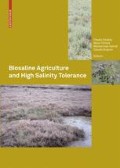Abstract
Tomato is moderately tolerant to salt. However, under stress conditions, antioxidative defense mechanisms in tomato are activated. The effects of diluted seawater on the antioxidant capacity, namely ascorbate, tocopherols and cellular redox status, have been evaluated in three tomato cultivars. Two salad tomato cultivars, Jama and Gimar and a cherry tomato cv. Naomi were used. Our results indicate that the three cultivars had different salt tolerance. Naomi showed the best adaptive response due to its increased antioxidant pool after salinization.
Access this chapter
Tax calculation will be finalised at checkout
Purchases are for personal use only
Preview
Unable to display preview. Download preview PDF.
References
Gawad G A, Arslan A, Gaihbe A., Kadouri F (2005) The effects of saline irrigation water management and salt tolerant tomato varieties on sustainable production of tomato in Syria (1999-2002). Agric Water Manag 78: 39–53
D’Amico ML, Navari-Izzo F, Sgherri C, Izzo R (2004) The role of lipoic acid in the regulation of the redox status of wheat irrigated with 20% seawater. Plant Physiol Biochem 42: 329–334
Hajer AS, Malibari AA, Al-Zahrani HS, Almaghrabi OA (2006) Responses of three tomato cultivars to seawater salinity. Effect of salinity on the seedling growth. Afr J Biotechnol 5: 855–861
Cuartero J, Fernandez-Munoz R (1999) Tomato and salinity. Sci Hort 78: 83–125
Ferrari CKB (2004) Functional foods, herbs and nutraceuticals: Towards biochemical mechanisms of healthy aging. Biogerontology 5: 275–289
Diplock AT, Agget PJ, Ashwell M, Bornet F, Fern EB, Roberfroid MB (1999) Scientific concepts of functional foods in Europe: Consensus Document. Br J Nutr 81: 1–27
Hercberg S, Galan P, Preziosi P, Alfarez MJ, Vazques C (1998) The potential role of antioxidant vitamins in preventing cardiovascular diseases and cancer. Nutrition 14: 513–520
Blum A, Monir M, Wirsansky I, Ben-Arz S (2005) The beneficial effects of tomatoes. Eur J Intern Med 16: 402–404
Willcox JK, Catignani GL, Lazarus S (2003) Tomatoes and cardiovascular health. Crit Rev Food Sci Nutr 43: 1–18
De Pascale S, Maggio A, Fogliano V, Ambrosino P, Ritieni A (2001) Irrigation with saline water improves carotenoids content and antioxidant activity of tomato. J Hort Sci Biotechnol 76: 447–453
D’Amico ML, Izzo R,Tognoni F, Pardossi A, Navari-Izzo F (2003) Application of diluted sea water to soil-less culture of tomato (Lycopersicon esculentum Mill.): Effects on plant growth, yield, fruit quality and antioxidant capacity. Food Agric Environ 1: 112–
Krauss S, Schnitzler WH, Grassmann J, Woitke M (2006) The influence of different electrical conductivity values in a simplified recirculating soilless system on inner and outer fruit quality characteristics of tomato. J Agric Food Chem 54: 441–448
Quartacci MF, Cosi E, Navari-Izzo F (2001) Lipids and NADPH-dependent superoxide production in plasma membrane vesicles from roots of wheat grown under copper deficiency or excess. J Exp Bot 52: 77–84
Galatro A, Simontacchi M, Puntaruolo S (2001) Free radical generation and antioxidant content in chloroplasts from soybean leaves exposed to ultraviolet-B. Physiol Plant 113: 564–570
Sgherri C, Quartacci MF, Izzo R, Navari-Izzo F (2002) Relation between lipoic acid and cell redox status in wheat grown in excess copper. Plant Physiol Biochem 40: 591–597
Meneguzzo S, Navari-Izzo F, Izzo R (1999) Antioxidative responses of shoots and roots of wheat to increasing NaCl concentrations. J Plant Physiol 155: 274–280
Olsson ME, Gustavsson KE, Andersson S, Nilsson A, Duan RD (2004) Inhibition of cancer cell proliferation in vitro by fruit and berry extracts and correlations with antioxidant levels. J Agric Food Chem 52: 7264–7271
Hernandez JA, Jimenez A, Mullineaux P, Sevilla F (2000) Tolerance of pea (Pisum tsativum L.) to long-term salt is associated with induction of antioxidant defences. Plant Cell Environ 23: 853–862
Navari-Izzo F, Rascio N (1999) Plant response to water-deficit conditions. In: M. Pessarakli (ed): Handbook of plant and crop stress. Marcel Dekker, New York, 231–270
Brigelius-Flohè R, Traber MG (1999) Vitamin E: function and metabolism. FASEB J 13: 1145–1155
Abushita AA, Daood HG, Biacs PA (2000) Change in carotenoids and antioxidant vitamins in tomato as a function of varietal and technological factors. J Agric Food Chem 48:2075–2078
Chericoni L (2005) Markers per l’identificazione precoce di stress ossidativo in piante di grano cresciute in eccesso di rame. Degree thesis, University of Pisa, Italy
Sgherri C, Kadlecovà Z, Chericoni L, Izzo R, Navari-Izzo F (2004) Ruolo dei tocoferoli in grano e pomodoro: Effetti di stress diversi. Atti del XXII Convegno SICA, Perugia, 263–267
Author information
Authors and Affiliations
Editor information
Editors and Affiliations
Rights and permissions
Copyright information
© 2008 Birkhäuser Verlag/Switzerland
About this paper
Cite this paper
Incerti, A., Izzo, R., Belligno, A., Navari-Izzo, F. (2008). Seawater effects on antioxidant production in berries of three cultivars of tomato (Lycopersicon esculentum mill.). In: Abdelly, C., Öztürk, M., Ashraf, M., Grignon, C. (eds) Biosaline Agriculture and High Salinity Tolerance. Birkhäuser Basel. https://doi.org/10.1007/978-3-7643-8554-5_4
Download citation
DOI: https://doi.org/10.1007/978-3-7643-8554-5_4
Publisher Name: Birkhäuser Basel
Print ISBN: 978-3-7643-8553-8
Online ISBN: 978-3-7643-8554-5
eBook Packages: Biomedical and Life SciencesBiomedical and Life Sciences (R0)

